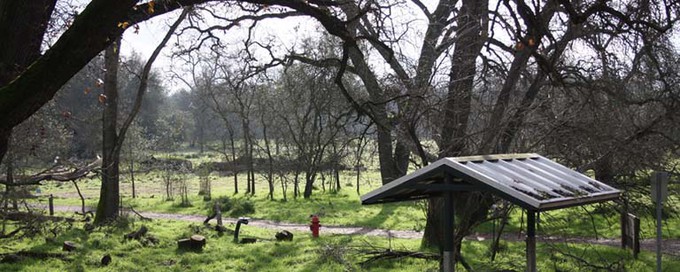
Effie Yeaw Nature Center in Carmichael hosts guided experience

Get outdoors in nature for a walk specifically designed to de-stress the walkers. Courtesy Effie Yeaw Nature Center
Feeling stressed? A walk in nature is a proven way to help ease tension and lower stress levels. Mother Nature is good for you; gardens in general can help you feel more relaxed.
Get in touch with nature while lowering your blood pressure during a special Nature and Forest Therapy Walk at 8 a.m. Saturday, Oct. 15, at Effie Yeaw Nature Center in Carmichael.
Nature and forest therapy guide Jane McCluskey will lead the way.
“The forest provides more than we typically perceive,” she says. “Have you caught yourself day dreaming as you look out a window? Caught yourself laughing with baby animal videos? Forest therapy walks are not nature hikes and not meditation retreats. Drawing from old traditions and relatively new findings, nature and forest walks are brief immersions into something you create with nature.
“Forest therapy walks are slow journeys through an area populated by natural life,” she explains. “We cannot tell you what you will experience; we can only tell you what we will be doing in these guided visits. We sometimes walk, sometimes we touch the earth, sometimes we sit and sometimes we do something different.”
This is not about exercise, she adds, but experiencing nature on a personal level.
At Effie Yeaw Nature Center, there’s plenty of nature to experience. Located close to the American River, the center reserves a slice of nature now surrounded by suburbia. See native oaks and the wildlife that make those trees their home. Explore the center’s picturesque plantings, designed with bees and butterflies in mind.
Fee is $35; advance registration is required. Additional Therapy Walks are planned for Nov. 12 and Dec 3. Effie Yeaw Nature Center is located at 2850 San Lorenzo Way, Carmichael.
Details and registration: https://www.sacnaturecenter.net/event/fall-nature-forest-therapy-walks/ or 916-489-4918.
Comments
0 comments have been posted.Sacramento Digs Gardening to your inbox.
Food in My Back Yard Series
May 6: Maintain soil moisture with mulch for garden success
April 29: What's (already) wrong with my tomato plants?
April 22: Should you stock up on fertilizer? (Yes!)
April 15: Grow culinary herbs in containers
April 8: When to plant summer vegetables
April 1: Don't be fooled by these garden myths
March 25: Fertilizer tips: How to 'feed' your vegetables for healthy growth
March 18: Time to give vegetable seedlings some more space
March 11: Ways to win the fight against weeds
March 4: Potatoes from the garden
Feb. 25: Plant a fruit tree now -- for later
Feb. 18: How to squeeze more food into less space
Feb. 11: When to plant? Consider staggering your transplants
Feb. 4: Starting in seed starting
Sites We Like
Garden Checklist for week of May 4
Enjoy this spring weather – and get gardening!
* Plant, plant, plant! It’s prime planting season in the Sacramento area. Time to set out those tomato transplants along with peppers and eggplants. Pinch off any flowers on new transplants to make them concentrate on establishing roots instead of setting premature fruit.
* Direct-seed melons, cucumbers, summer squash, corn, radishes, pumpkins and annual herbs such as basil.
* Harvest cabbage, lettuce, peas and green onions.
* In the flower garden, direct-seed sunflowers, cosmos, salvia, zinnias, marigolds, celosia and asters. (You also can transplant seedlings for many of the same flowers.)
* Plant dahlia tubers. Other perennials to set out include verbena, coreopsis, coneflower and astilbe.
* Transplant petunias, marigolds and perennial flowers such as astilbe, columbine, coneflowers, coreopsis, dahlias, rudbeckia and verbena.
* Keep an eye out for slugs, snails, earwigs and aphids that want to dine on tender new growth.
* Feed summer bloomers with a balanced fertilizer.
* For continued bloom, cut off spent flowers on roses as well as other flowering plants.
* Add mulch to the garden to maintain moisture. Mulch also cuts down on weeds. But don’t let it mound around the stems or trunks of trees or shrubs. Leave about a 6-inch to 1-foot circle to avoid crown rot or other problems.